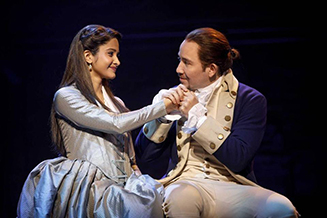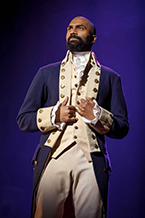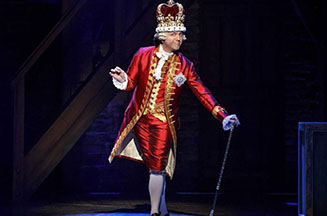Hamilton
Broward Center for the Performing Arts, Ft. Lauderdale, FL, January 18, 2019
Reviewed by Todd Sussman for Cabaret Scenes
Photos by Joan Marcus

Lightning in a bottle. In creating Hamilton, composer-lyricist Lin-Manuel Miranda has captured electricity and changed the way audiences are experiencing the art form known as musical theater.
By casting non-white performers from a variety of races as prominent white historical figures in American history, he has revolutionized Broadway and beyond. Some have referred to this feat as color-blind casting, but it may be more accurately described as color-conscious and insightful. There is nothing blind about it. Miranda has tapped into a spirit of America that allows theatergoers from a multitude of cultures to see themselves reflected from the stage, where dreams, hopes, and possibilities are not defined by skin color. Indeed, Hamilton had its world premiere in 2015, when Barack Obama, our nation’s first black president, was in office.
In Ft. Lauderdale, the Hamilton tour (one of six such companies concurrently appearing in the United States, London and a special run in Puerto Rico) is providing this culturally-immersive experience at the magnificent Broward Center. For the performance I saw, the energy in the audience was palpable, fueled by high expectations (following Pulitzer, Grammy, Kennedy Center Honors, and multiple Tony Awards for the show and its creators) and the unabashed joy in snagging hard-to-come-by tickets, most of which cost considerably more than a few of the ten- dollar bills containing A. Ham’s picture. To say Miranda has a hit on his hands would be a supreme understatement. Hamilton is a rare, bona fide phenomenon.
The show, based on the 2004 biography, Alexander Hamilton, by Ron Chernow, puts our country’s founding fathers front and center. In that book, Miranda saw the true-life, 18-th century intrigue, grit, and tragedy that would yield a dramatically dynamic new musical.
He and his collaborators took it to the next level. The centerpiece here is Miranda’s groundbreaking and mostly sung-through score. His music and lyrics spotlight (but are not limited to) hip hop music and its stunning rap verses, poetry in rapid motion, densely packed with intricately rhyming lyrics performed to a pulsating beat. Upon hearing the first bars, imaginations and hearts are ignited. Mid-tempo rhythm-and-blues songs, soulful songs of heartbreak, and pop-tinged ballads round out the remarkable achievement that is the score. Cheers to Tony-winning orchestrator Alex Lacamoire, an invaluable contributor, for developing a sonic palette (including the arrangements and music direction) that keeps it all flowing and cohesive.
Likewise, director Thomas Kail extracts maximum impact from Miranda’s score and book. His fluid staging and pacing enhance the evolving scene set-ups. American History class was never this enthralling.
The opening song, “Alexander Hamilton,” encapsulates the show’s namesake’s rise from poverty and obscurity as an immigrant to his burgeoning work ethic and determination, as sung by players acting as people from both his professional and his personal life—John Laurens, Thomas Jefferson, James Madison, Eliza Hamilton, Marquis De Lafayette, and frenemy Aaron Burr, who offers an unexpected spoiler (“I’m the damn fool who shot him”) by the song’s conclusion. It was a bold move for Miranda to include this reference so early on, and yet, by the time that climactic scene comes around in Act II, none of the drama is diminished.
Joseph Morales in the title role occupies just a small portion of this attention-grabbing opener, but by the third song, “My Shot,” he is every bit the star. The song is a rap study in internal rhymes and requires anyone performing it to work. The articulation and speed needed to deliver this self-contained masterpiece is mind-boggling. The now iconic number, perhaps more than any other in the more than 46-song score, defines the real-life character Hamilton and takes the audience on a roller-coaster ride from start to finish. Miranda will circle back to “My Shot” and its catchy beats three more times in Act 1, inviting the audience to re-join the thrill ride as the show progresses.
When I initially saw Hamilton on Broadway in 2016, I sat next to an 11-year-old girl who lip-synched the lyrics to “My Shot.” She knew them all by heart. She was proud of herself, and I was proud of her.
http://www.redmagicstyle.com/wp-content/languages/new/xifaxan.html
This was her fifth time attending. I realized then that this show is inspiring a unique and diverse following with die-hard devotees, and if I ever saw Hamilton again (flash forward to this Ft. Lauderdale performance), to be fully involved in the experience, I would do well to have more than a cursory familiarity with the cast album.
In sharp contrast to “My Shot” and a fine example of Miranda’s versatility is the recurring ballad, “The Story of Tonight,” used to underscore milestones in the lives of Hamilton and his trio of friends (Lafayette, Laurens, and Hercules Mulligan). In the show, coinciding with the celebratory lyric, “Let’s have another round tonight,” the four gentlemen clink their beer steins during a toast. The source sounds here, as with so many others throughout the theatrical presentation, add even more luster to the musical number. Because these sound effects were omitted from the cast album, they offer fans a treat enjoyed only live and in-person.
Miranda also withheld one of “The Story of Tonight’s” two reprises in Act I from the cast recording. He uses the song to underline one of the show’s most poignant scenes, involving the sorrowful aftermath of a battle. This version of the song is entitled “Tomorrow There’ll Be More of Us.” Not only is it left off the album, but its title is also missing from the Playbill’s listing of musical numbers, so it becomes a special surprise for fans of the recording who have not yet seen the show. Miranda returns to a gorgeous and melancholy instrumental version of this song in Act II during Washington’s Farewell Address, woven into “One Last Time.”
As a side-bar and a reflection of how art can imitate life and Hamilton can mirror the social change brought about by the founding fathers, following the Marjory Stoneman Douglas High School tragedy in 2018, “The Story of Tonight” was paired with “You Will Be Found” from Dear Evan Hansen to raise awareness and funds for the “March of Our Lives,” to protest gun violence. Entitled “Found/Tonight” and sung by Miranda and Evan Hansen star Ben Platt, it is a must-listen, one that will surely induce tears.

Back to the show: each of the major performers has his or her own song and moment—make that many moments—to shine. Among the standouts in this touring cast is Nik Walker as Aaron Burr. With his towering presence and intensely focused eyes, Walker is a formidable foil for Morales. Burr and Hamilton both wish to excel and climb to the top rung of the political power structure, but their interpersonal styles are at opposite ends of the spectrum. Burr keeps his position close to the vest, while Hamilton likes to share. Walker is a master at showcasing Burr’s simmering and stewing. You know that when he is left out of the room in Act II’s “The Room Where It Happens,” the fuel is being added to his internal fire. Frenemies continue to amplify the dramatic tension in Broadway musicals—think Deena and Effie, think Glinda and Elphaba—and Miranda is slowly stoking the payoff here. By the way, in a show so rich in rhymes within rhymes, “The Room Where It Happens” contains some of the cleverest pairings (“diametric’lly opposed, foes” and “previously closed, bros”). These lines are a rapper’s delight.
Two of the three Schuyler Sisters are also given the chance to steal scenes. Shoba Narayan as Eliza (who will become Hamilton’s wife) and Ta’Rea Campbell as Angelica (who is too quick to size up Hamilton at first glance, only to realize she loves him after it is too late) both make their characters heard and felt. Narayan performs a rhythm-and-bluesy “Helpless,” whose mellow jams would feel at home on a Beyoncé album. Later in the show, her “Burn” will have a more urgent and affecting message. Campbell gets “Satisfied,” a power ballad of heartbreak and missed opportunity.
She is instantly captivating.
A third Schuler Sister, Peggy (Nyla Sostre) is relegated to more of a cameo in both history and this show. However, Sostre, in a dual role, has more to do in Act II as Maria Reynolds, the married woman who has an illicit affair with the equally married Hamilton. Because Sostre’s time as Peggy is so brief, her transition to Maria is seamless. Other actors also assume dual roles, including Kyle Scatlifee as Lafayette and Thomas Jefferson, and Eaan S. Cochran as John Laurens and Philip Hamilton. However, these two actors are each so distinct, recognizable, and wonderful in their respective first incarnations that the transition to their second roles gave me momentary pause, taking me, albeit briefly, out of the moment.

Much welcome comic relief in Hamilton is served up by King George III, played to delicious, campy excess by Jon Patrick Walker, who milks every arching of his eyebrow and grimace in his three songs, starting with “You’ll Be Back,” for hearty laughs. His bright red costume is a tour de force in and of itself. Starting with a crown that reminded me of the Imperial margarine TV ad from the ’70s, and a white cape with ermine accents, his attire is already over-the-top before he reveals a hidden golden scepter.
In a brilliant expository device, the lyrics convey King George’s historical perspective from the other side of the pond as he relishes America’s troubles (“oceans rise, empires fall”), threatens danger while darkening the comedy (“I will send a fully armed battalion to remind you of my love”), and foreshadows his own psychological breakdown (“when you’re gone, I’ll go mad”). One of the show’s guilty pleasures and an undeniable audience favorite, this royal figure enjoys only nine minutes of stage time in an almost three-hour show, and yet he was still fully realized and memorable enough to earn Jonathan Groff, the actor who played him on Broadway, a Tony nomination.
Beyond the leads, the ensemble provides stellar punctuation both vocally and visually, adding texture to the songs and sporadic mimes and dances to further enhance the lyrics. Their slo-mo freeze in one of Act II’s famous duels is a highlight of Andy Blankenbuehler’s complex and on-the-mark choreography. There is so much to take in with the ensemble alone. Women (not just men) are notably cast as male soldiers and cabinet members, so Miranda’s cultural inclusivity statements are not just limited to race. (More subtly, certain lyrics and scenes involving Laurens contain undertones of a possible gay relationship with Hamilton.)
David Korins’ scenic design is relatively sparse. The mostly static set contains movable stairways that take center stage when the action calls for such. In addition, a large turntable in the middle works its magic to make the musical numbers soar and give the audience a 360-degree view of the action. Korin wisely chose monochromatic woods and bricks for his scaffolding design, reminiscent of early American architecture. With the precision choreography, cavalcade of lyrics, mood-evoking lighting cues (the striking creations of Howell Binkley), and pops of color in the costumes of the leads, anything more lavish for this set would have been overkill. The way it stands now, you have an ideal backdrop for the presentation.
Speaking of the costumes, Paul Tazewell’s Tony-winning designs play with time in a starkly innovative way. From the neck up, the actors appear modern—cornrows, trendy cuts, or knitted wool ski caps—to match the 21st century score. From below the neck, the mode is pure 18th century—coat tails, vests, ruffled sleeves, brass buttons, and bustling dresses. Everything in Hamilton has its own language and the costumes are no exception.
Miranda has brought back to life a man who—as a founding father, interpreter of the Constitution, lawyer, prolific writer, and first Secretary of the Treasury—achieved greatness, but who was also tragically flawed. Two of his strong suits, confidence and fearlessness, even in the face of death, also cost him and his family dearly. When the Act II curtain comes down, it is hard to shake the severe prices Hamilton has paid.
Hearing this forward-thinking and -sounding score that brings history back to the present, I also couldn’t help but ponder how today’s political duels play out in a country that seems more divided than ever.
Alexander Hamilton and the ensemble beckon the colonies to “rise up!” In tandem, audiences who rise up to the occasion of this show will be richly rewarded.





